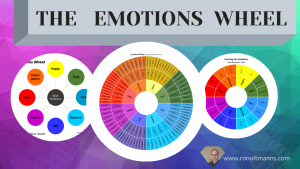The emotions wheel is a really useful tool for expanding your self awareness and vocabulary for feelings. You’re in the right place to get the emotions wheel explained.
Most people know more words than they use when it comes to describing their emotions. Ask a group of people in almost any training class which emotions they are aware of. The responses usually include “glad”, “sad” and “mad”. Even people who have a large vocabulary for business or their technical field have a very elementary vocabulary for naming their emotions.
Learn how to use the feelings wheel to increase your vocabulary for emotions
Naming our feelings is a key part of emotional intelligence. The simple act of putting a feeling into words increases our self awareness. Studies prove the little known fact that it also helps you better manage your emotions.
As I started to improve my emotional intelligence and found out about the feelings wheel, I went looking for a good tool and I noticed a few things.
There are many different emotions wheels available, and many of them honestly aren’t that good. Whether it’s bad color sense or a poor layout or a flawed model of emotions underlying it, the tools don’t really get the job done. After some research, I decided to work from Robert Plutchik’s wheel of emotions as the model and build on it.
I wanted something practical and useful but based on sound science. Plutchik analyzed human and animal emotions and discovered eight basic ones. Happy, Sad, Fear, Anger, Trust, Disgust, Surprise, and Anticipation. Working out from these eight, you can make more granular distinctions among different emotions. The full emotions wheel with 128 emotions is the result.

However, I noticed that most people know more than a few words related to feelings, but they don’t use them that often. People actually need some training for tuning into their emotions. We also need the emotions wheel explained to help us find our way. We need some training wheels before we go out exploring!
Pick the best wheel for you!
The basic wheels that have 8 and 24 or 32 emotions on them are perfect for learning the language of emotion without being overwhelmed. As you gain more skill in naming emotions, you’ll want to move on to the full emotions wheel with 128 different emotions on it. Maybe you’ll even want to post wheels around the workplace or in different rooms in your home!
Start working with an emotions wheel in order to increase your self awareness and also your sense of control over your emotions. Get your own wheel(s) here:
